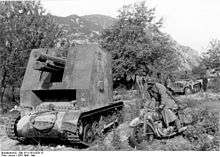15 cm sIG 33 (Sf) auf Panzerkampfwagen I Ausf B
| 15 cm sIG 33 (Sf) auf Panzerkampfwagen I Ausf B | |
|---|---|
|
A sIG 33 (Sf) on a Pz.Kpfw. I chassis in Russia, 1942 | |
| Type | self propelled artillery |
| Place of origin | Nazi Germany |
| Service history | |
| In service | 1940 - 1943 |
| Used by | Nazi Germany |
| Wars | World War II |
| Production history | |
| Designed | 1939-1940 |
| Manufacturer | Alkett |
| Produced | February 1940 |
| Number built | 38 |
| Specifications | |
| Weight | 8.5 tonnes (8.4 long tons; 9.4 short tons) |
| Length | 4.67 metres (15 ft 4 in) |
| Width | 2.06 metres (6 ft 9 in) |
| Height | 2.8 metres (9 ft 2 in) |
| Crew | Four |
|
| |
| Armor | 13 mm - 5 mm |
Main armament | 1× 15 cm schweres Infanteriegeschütz 33 |
| Engine |
6-cylinder, water-cooled Maybach NL38TR 100 horsepower (75 kW) |
| Transmission | 5 forward, 1 reverse gears |
Operational range | 140 kilometres (87 mi) |
| Speed | 40 kilometres per hour (25 mph) |
The 15 cm sIG 33 (Sf) auf Panzerkampfwagen I Ausf B (sometimes referred to as the Sturmpanzer I Bison[1]) was a German self-propelled heavy infantry gun used during World War II.
Development and history
The Invasion of Poland had shown that the towed sIG 33 guns assigned to the infantry gun companies of the motorized infantry regiments had difficulties keeping up with the tanks during combat. The easiest solution was to modify a spare tank chassis to carry it into battle. A sIG 33 was mounted on the chassis of the Panzer I Ausf. B, complete with carriage and wheels, in place of the turret and superstructure. Plates 13 millimetres (0.51 in) thick were used to form a tall, open-topped fighting compartment on the forward part of the hull. This protected little more than the gun and the gunner himself from small arms fire and shell fragments, the loaders being completely exposed. The rearmost section of armor was hinged to ease reloading.
There was no room to stow any ammunition so it had to be carried by a separate vehicle. When mounted, the sIG 33 had a total 25° of traverse and could elevate from -4° to +75°. It used a Rblf36 sight. The chassis was overloaded and breakdowns were frequent. The vehicle's extreme height and lack of on-board ammunition were severe tactical drawbacks.
Thirty-eight were produced in February 1940 by Alkett.
Combat use

Thirty-six vehicles were organized into independent schwere Infanteriegeschütz-Kompanie ("self-propelled heavy infantry gun companies") mot.S. numbers 701-706, assigned to Panzer divisions in the Battle of France[2] as follows: [3]
- Company 701, to the 9th Panzer Division
- Company 702, to the 1st Panzer Division
- Company 703, to the 2nd Panzer Division
- Company 704, to the 5th Panzer Division
- Company 705, to the 7th Panzer Division
- Company 706, to the 10th Panzer Division
As part of the 5th Panzer Division, assigned to the German XIVth Motorized Army Corps, the 704th company participated in Operation Marita, the invasion of the Balkans.[4]
Later in 1941, the same assignment was maintained for Operation Barbarossa, the invasion of the Soviet Union.[5] The 705th and 706th belonging to the 7th and 10th Panzer Divisions respectively, were destroyed at this time. Of the remaining companies, only the 701st participated in the opening stages of the subsequent Case Blue in 1942, although it, and its parent 9th Panzer Division, were transferred to Army Group Center by the end of the summer of 1942.[6]
The last reference to these vehicles is with the 704th Company of the 5th Panzer Division during the middle of 1943.[7]
Notes
- ↑ Achtung Panzer Article
- ↑ Trojca & Jaugitz, p. 5
- ↑ "Lexicon der Wehrmacht, Panzerkampfwagen I" (accessed 2014-03-10)
- ↑
- ↑ Niehorster, 1941
- ↑ Niehorster, 1942
- ↑ Chamberlain & Doyle, p. 24
References
- Chamberlain, Peter, and Hilary L. Doyle. Thomas L. Jentz (Technical Editor). Encyclopedia of German Tanks of World War Two: A Complete Illustrated Directory of German Battle Tanks, Armoured Cars, Self-propelled Guns, and Semi-tracked Vehicles, 1933–1945. London: Arms and Armour Press, 1978 (revised edition 1993) ISBN 1-85409-214-6.
- Niehorster, Leo. German World War II Organizational Series; Volume 3/I: Mechanized Army Divisions (22 June 1941) Hannover, Germany: Niehorster, 1990
- Niehorster, Leo. German World War II Organizational Series; Volume 4/I: Mechanized Army Divisions (28 June 1942) Hannover, Germany: Niehorster, 1994
- Trojca, Waldemar and Jaugitz, Markus. Sturmtiger and Sturmpanzer in Combat. Katowice, Poland: Model Hobby, 2008 ISBN 978-83-60041-29-1
External links
- Panzers of the Reich
- wwiivehicles.com
- (German) "Lexicon der Wehrmacht" site, "Panzerkampfwagen I" page (accessed 2041-03-10)
